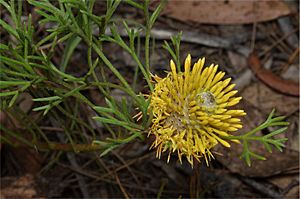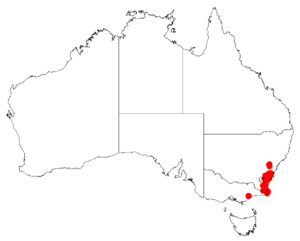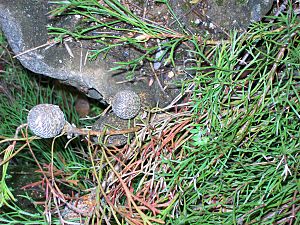Prostrate cone-bush facts for kids
Quick facts for kids Prostrate cone-bush |
|
|---|---|
 |
|
| Scientific classification | |
| Genus: |
Isopogon
|
| Species: |
prostratus
|
 |
|
| Occurrence data from Australasian Virtual Herbarium | |
| Synonyms | |
The Isopogon prostratus, often called the prostrate cone-bush, is a unique plant that belongs to the Proteaceae family. It is found only in south-eastern Australia. This plant is a low-growing shrub with leaves that are divided into thin, long sections. It produces round clusters of yellow flowers at the ends of its branches.
What Does It Look Like?
The prostrate cone-bush is a low, spreading shrub that usually grows up to about 1 meter (3 feet) wide. It has reddish branches. Its leaves are typically 40 to 100 millimeters (about 1.5 to 4 inches) long. They are divided into thin, straight parts, each about 1 to 2 millimeters wide. These leaves grow on a stalk called a petiole, which can be up to 60 millimeters long. The flowers are bright yellow and grow in round clusters, about 25 to 35 millimeters (1 to 1.4 inches) across. These clusters sit directly on the ends of the branches. At the base of these flower clusters are egg-shaped leaves called involucral bracts. Each flower is about 12 millimeters long and is mostly smooth (glabrous). The prostrate cone-bush usually flowers from October to December. After flowering, it produces a hairy fruit called a nut. Many of these nuts grow together to form a round head, about 20 millimeters across.
How It Got Its Name
The Isopogon prostratus was first officially described in 1975 by a scientist named Donald McGillivray. He wrote about it in a science journal called Telopea. He based his description on plant samples collected in 1860 by Ferdinand von Mueller near Twofold Bay.
Where Does It Grow?
This type of isopogon plant usually grows in open areas like heath (a type of shrubland) or forests. It often prefers exposed places on the high lands, known as tablelands. In New South Wales, you can find it between the Newnes Plateau and the Tuross River. In Victoria, it is only found in two separate areas: near Providence Ponds and on the Howe Range.


